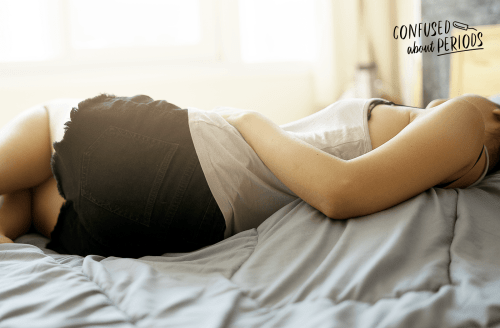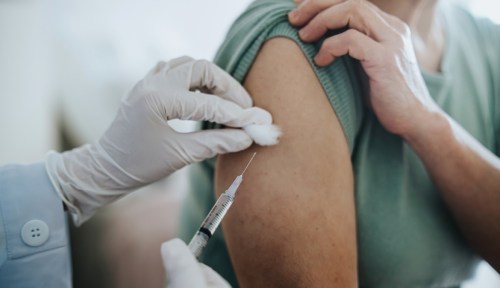Your menstrual cycle is way bigger than just your period—here’s how it all goes down
Don't know what's going on during your menstrual cycle? You're not alone. We asked two doctors to explain every phase from ovulation to periods.

Here’s a pop quiz for you: How long is the average person’s menstrual cycle? (No, you’re not allowed to Google it!)
Stumped? You’re not alone. The average person will spend about 40 years of their life having periods. Yet most of us don’t fully understand the nitty-gritty process behind their monthly bleeding. A small 2016 survey found that while an encouraging 80 percent of women knew about their reproductive anatomy, 46 percent didn’t know what ovulation was and 50 percent didn’t know how long the average menstrual cycle lasts. (The answer, BTW, is 28 days, although it can be as short as 21 days and as long as 32.)
From a purely biological standpoint, “the menstrual cycle exists to support a pregnancy,” says Molly Moravek, MD, MPH, a reproductive endocrinologist and assistant professor of obstetrics and gynecology at the University of Michigan. No matter your stance on having kids, it’s important for people to understand what’s going on with their cycles, adds Nazaneen Homaifar, MD, MBA, an OB/GYN and clinical instructor of obstetrics, gynecology, and reproductive sciences at the University of California, San Francisco. A regular menstrual cycle can be a sign of good health and is connected intimately to the functioning of your hormones.
Knowing what’s happening with your body every month can help take a bit of the mystery out of the fertility process if a person decides to have kids, says Dr. Homaifar. “It’s not like you just have sex and you get pregnant. That’s what we are taught in sex-ed, but you actually have to time it at a certain time, and a lot has to happen for you to be able to get pregnant.” (So Coach Carr in Mean Girls was wrong this whole time?)
To be fair to all of us scratching our heads, the menstrual cycle is super complex. It involves the ovaries, the uterus, parts of the brain, and a bunch of different hormones. To make things easier, we talked to Dr. Moravek and Dr. Homaifar to help break things down. Consider period school officially in session.
Part one: the follicular phase
The first day of your period is technically considered day one of your menstrual cycle. The Office on Women’s Health reports that the average menstrual cycle lasts 28 days, although some people have shorter cycles and some have slightly longer cycles.
While your uterus sheds its lining out the vagina in the form of your period (more on that in a bit) at the start of your cycle, the pea-sized pituitary gland at the base of your brain sends a hormone called follicle-stimulating hormone (FSH) down to the ovaries. The FSH stimulates your ovarian follicles (vessels where immature eggs are housed) to grow and mature an egg, says Dr. Moravek.
As a few of these follicles grow, they release the hormone estrogen into the bloodstream. Estrogen tells the endometrium (your uterine lining) to grow and thicken in order to support a potential fertilized egg. “This is all in preparation to reproduce,” Dr. Moravek says. “While the egg is growing, the body is simultaneously building a lining to support pregnancy if one were to occur.”
Part two: ovulation
Once your estrogen levels get high enough, your brain releases another hormone called luteinizing hormone (LH), says Dr. Moravek. The surge in LH (along with more FSH), which lasts for about a day or two, forces your ovary to release a mature egg into the adjoining fallopian tube. The egg literally bursts or pops through the follicle—something that some people can feel in the form of a sharp cramp or ache on one side or the other. This is called ovulation, and it happens between day 11 to 21 of your cycle.
A person is most likely to become pregnant during the three to five day ovulation period. That’s why Dr. Moravek says many fertility trackers and kits measure a person’s LH levels—a sudden rise in LH is a huge predictor of ovulation. This is also when estrogen levels are at their highest, which might lead to increased sex drive, more vaginal lubrication, and even better, clearer skin.
Part three: the luteal phase
Once the egg is released from the ovary, it hangs out in your fallopian tube waiting to be fertilized by a sperm. It can live for up to 24 hours post-ovulation. If it’s fertilized, it will travel to the uterus, where it will likely implant in the cushy endometrium and start growing into a fetus.
If the egg does not get fertilized, this kicks off what’s called the luteal phase of your cycle. This is the back half of your cycle—which wraps up in about 14 to 16 days after ovulation. The follicle that released the egg becomes a corpus luteum—a temporary gland that releases massive amounts of progesterone. The progesterone stabilizes the growth of the endometrial lining and makes it ready for an embryo, says Dr. Moravek. The rise in progesterone (and subsequent dips in estrogen in response) also signals to the brain to put the brakes on FSH. The hormone shift also might reduce your sex drive.
About a week before your period (once it’s clear to your body that you’re not pregnant), the corpus luteum shrivels up and stops producing progesterone. Your overall hormone levels plummet, which leads to all of your favorite fun PMS symptoms like mood swings, cramps, breakouts, and bloating. “I would say progesterone probably drives a lot of what women are feeling more than any of the other hormones,” Dr. Moravek says—particularly the drop-off in progesterone at the end of your cycle.
Part four: mensuration
Remember how your progesterone levels dropped? That paves the way for your period. “Once there’s no more progesterone, the lining of the uterus is no longer stabilized and it bleeds,” Dr. Moravek says. “Now we’re back at day one.” The endometrium releases from the walls of your uterus and travel through the cervix and vagina out of your body (along with the dissolved, unfertilized egg) and into your tampon, pad, menstrual cup, or other menstrual product of choice. Your estrogen and progesterone levels are now at their lowest—a signal for the brain to increase FSH levels and start the whole cycle back over again.
Want more knowledge? We’re over here busting myths about “period syncing” and the alleged dangers of swimming in the ocean during your period.
Sign Up for Our Daily Newsletter
Get all the latest in wellness, trends, food, fitness, beauty, and more delivered right to your inbox.
Got it, you've been added to our email list.










